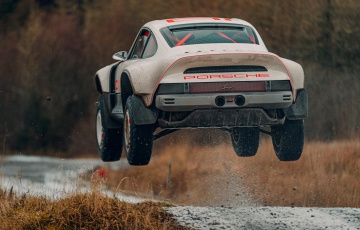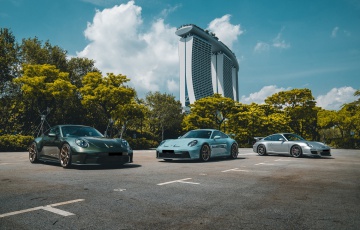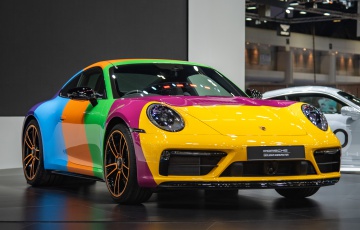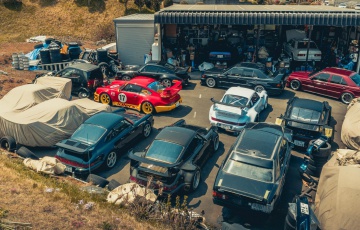Ebony & Ivory : Porsche 911 (996) Turbo x 911 Carrera 4 S (992 C4S) Drive [review]





Porsche 911 (996) Turbo x 911 Carrera 4 S (992 C4S) Drive Review : Ebony & Ivory
Be it big T or small t, Dr. Leroy McCully discovers that the Porsche turbo'd flat-six is capable of such sweet music
Singapore - Turbo. A single evocative name that only ever applied to one car, the mighty Porsche 911 Turbo.
Since its launch in the 70s, the Turbo has been the big daddy of the sportscar establishment. 911s were always known for being difficult cars to pedal quickly due to their light front ends and pendulous rears, but the Turbo went even further.
With huge power and tricky handling at the limit, its status was legendary. Only true drivers need apply.
Over the years and successive generations, the Turbo became more mature and civilised, gaining all-wheel-drive, twin turbochargers as well as every conceivable high-end option that was available.
Porsche had decided that the GT3 would pursue the role of the mental cousin while the flagship Turbo assumed the role of the consummate, suave gentleman from Zuffenhausen.





Porsche 911 Turbo (type 996)
When the 996 was launched in 1997, purists were up in arms as Porsche decided to switch to water-cooling for their engines.
The strange-looking headlights also did it no favours. Even though the engine was more efficient and powerful, and the body larger and lighter, the 996 was not an immediate hit.
When Porsche launched the 996 Turbo two years later, they decided not to use the new water-cooled engine from the 996 but instead opted for the tried and tested Mezger engine, albeit in water-cooled guise.
This engine had already tasted immense success in endurance racing and was known to be powerful and reliable.








Porsche 911 Turbo (type 996)
My black 996 Turbo is a year 2000 model and came generously fitted (courtesy of the first owner) with optional extras like the full carbon interior trim, leather wrapped dashboard, comfort seats and suede roof-lining.
Standard features include the sunroof, high end sound system and limited slip differential.
When I found this car in 2011, prices of 996s were low as it was shunned by Porsche purists who questioned its water-cooled engine and unusual looks.
All this was good news to me as it wasn’t too painful to purchase a car that was known to be hardy and reliable.
In the last nine years of ownership, it has covered 70,000 trouble-free kilometres that span work commutes to cross-border road-trip holidays.
My favourite journeys have been to Malaysia and Thailand, where the car’s sole purpose was to transport two people and their luggage over long distances at speed and supreme comfort.






The 420hp/560Nm output enables the 996 Turbo to cover the benchmark 0-100km/h in under 5secs; pedal-to-metal, it would hit a vmax just shy of 300km/h – in the world of 1999, the 996 Turbo’s performance was truly otherworldly.
According to the Internet, a simple software upgrade would easily increase the output to 600hp without troubling the gearbox or brakes. It’s incredibly tempting but I decided against it for the sake of my driving licence.
At its launch, the 996 Turbo was the flagship of the series. Fast forward 20 years and the model in the current 992 range that most closely resembles our 996 Turbo on paper is the new Carrera 4S (or C4S for short). Itself twin-turbocharged (albeit in 3.0- litre guise), featuring four-wheel drive and with similar weight and output.
(Click HERE to find out how the 992 Carrera S (C2S) drives)




Side by side with the latest Porsche 992, the 996 is dwarfed in all regards. The new car is longer (4519mm vs 4435mm), wider (1852mm vs 1830mm, and currently only one wide-body style for the 992 series for both C2S and C4S), almost the same kerbweight (992 C4S:1565kg vs 996 Turbo:1585kg), and puts out 450hp (versus the 996 Turbo’s 420hp).
Externally, both cars are unmistakably Porsches, but it’s under the skin that things have changed. In the driver’s seat.
The 996 feels decidedly narrow, but it’s not cramped. The seats are less plush, yet no less supportive.
The instrument cluster has the centrally-mounted tachometer that has not changed since the original 911 and the old style buttons and switches may date the car, but still work as intended.










Porsche 911 Carrera 4S (type 992 C4S)
The 992’s cabin is a lifetime away from the 996’s, with virtual instruments and touch-sensitive screens galore.
The gear selector is gone, replaced by something that looks like a WiFi dongle. With plush leather and soft surfaces everywhere, it really is a wonderful place to be in.
The older car has aged well, but there are some minor creaks when the car goes over transverse bumps and ridges, a bit like an elderly person climbing the stairs or bending down.
The new one has no such problems, all is silent on the move and even when the sports exhaust is activated, the sound of the engine never becomes anything more than a growl in the background.

On the go, the improvements are even more stark. The 996 may be almost 20 years old but it still has the goods.
The twin-turbo’d 3.6-litre is no slouch, but you’ll need at least 3000rpm to awaken the turbos and build meaningful boost.
Once on boost though, all 420hp is deployed via the all-wheel drivetrain and the car rockets down the straights to devastating effect and without any wasted energy.
The 996 makes do with a 5spd Tiptronic S auto that can be manually selected via switches on the 3 and 9 o’clock positions on the steering wheel.
By today’s standards, the gear changes are tardy, taking more than a second sometimes to switch ratios.
Fortunately the engine has loads of torque and the gearing is quite widely spaced so third and fourth gear are more than adequate for making safe and fuss-free overtakes.







Porsche 911 Carrera 4 S (992 C4S)
The new one responds energetically to every millimetre of pedal travel.
Lag is virtually non-existent and the sports exhaust makes enough effort to let you know which part of the rev range you are in, with the now-customary pops and crackles when you downshift or come off the throttle.
The 992 has the latest 8spd PDK dual-clutch gearbox and it is quite a busy thing, constantly shuffling up and down the gears in pursuit of fuel consumption figures.
The problem is when you need to get sudden get-up-and-go, as in overtaking, there is a little lag as the computer tries to predict whether to drop a gear or two to get going.
Of course, it’s much easier to use the paddles that reside behind the wheel to overcome such tardiness.



Porsche 911 Carrera 4S (992 C4 S)
The 992 rides in a very broad-shouldered and meaty manner, thanks to its wide stance and immense 20/21 inch staggered rims.
The cabin is the epitome of serenity and calm with all but the harshest bumps and ridges intruding.
Sharpening up the suspension is a mere button press away and you can feel the ride tensing up in anticipation.
The poor old 996 has no such refinements, and it makes do with non-adjustable passive dampers.
However, it’s a credit to the engineers that the car rides so well.
At low speed, the car does fidget a little but once velocity increases, it calms down significantly and the sound of the engine washes away in the wake of the car’s passing.
Not everything about progress is good though. One thing that the 996 outshines the new car is in steering feel.
Switching to electric power steering has robbed the 992 of this.
In isolation, the power and handling of the new car make this less significant but once in the 996, the difference is like letting the blind see.
In the 996, the steering is a living thing, gently writhing with the contours of the road.
The weighting also changes with the load of the front tires, giving the driver a high-definition image of what the tyres are doing and telling you exactly how hard they are working.
Granted, the 992 is a big improvement over the 991 and I’m sure the next generation will get even better in clarity.

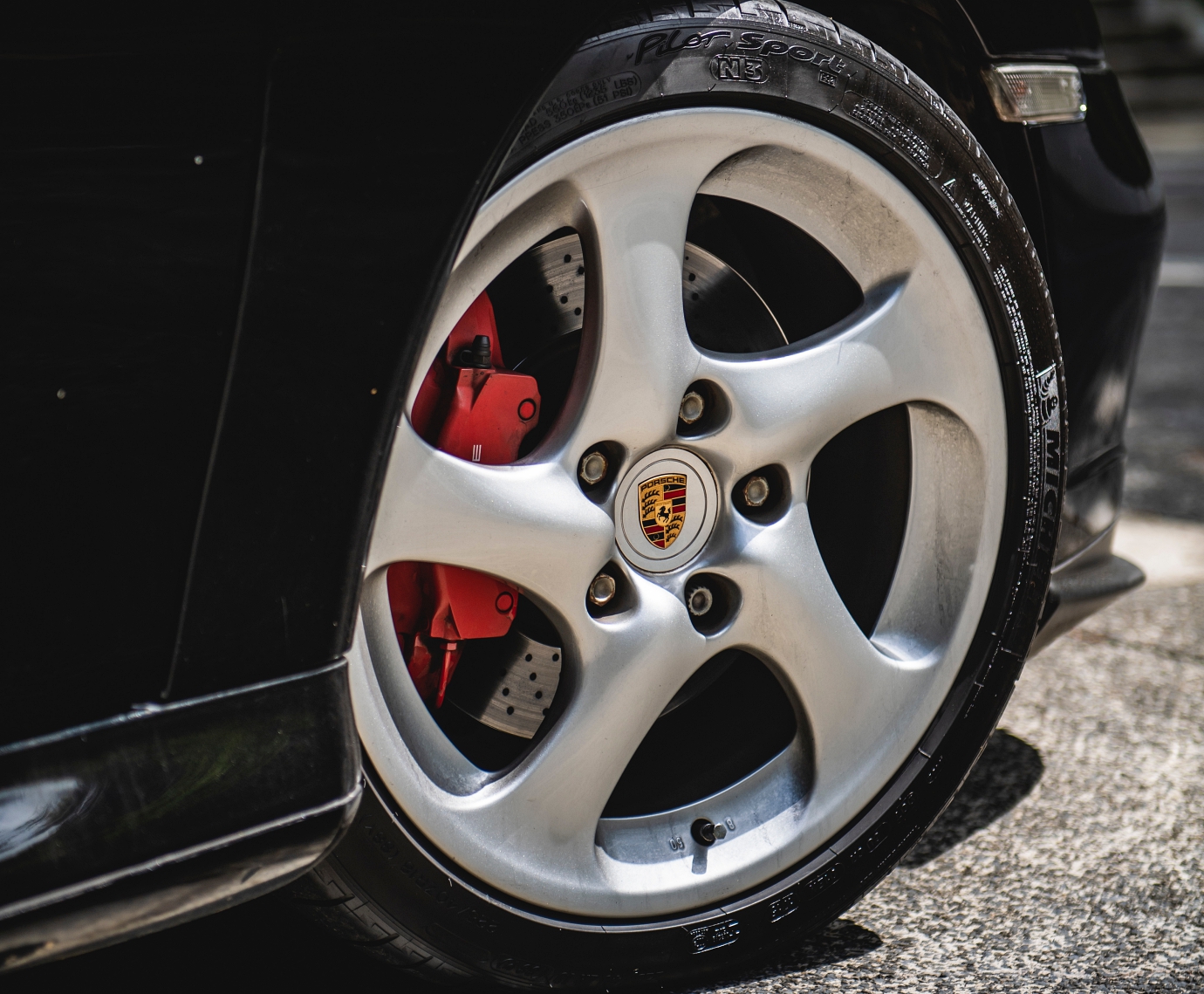
The 992 rides on 20-inch tires in front (245/35) and 21-inch (305/30) behind. The 996 Turbo looks puny in comparison with its 18-inch wheels (225/40 and 295/30).
However with 4WD, grip is assured and cornering speeds are high. Understeer occurs earlier in the older car but one has to be going very quickly in a tight corner to provoke it.
The same goes for oversteer as the fat rear tires in both cars ensure they hold on far beyond belief.
The huge rims on the 992 allow them to accommodate brakes that dwarf the 996’s.
However, in spirited driving, both cars demonstrate excellent feel and stopping power that’s available from the very top of the pedal, making it very easy to modulate the rate of deceleration.



Overall, the 992 is living proof of the relentless development of the 911 over the last four decades.
It is certainly a desirable addition to any garage and I honestly can’t imagine how the yet-to-be launched 992 Turbo would top it in everyday situations.
As much as I would love to have a 992 C4S, I’m happy (and relieved) that my 996 Turbo still has its charm.
Perhaps when my Toto ticket win comes in I’ll make space in my garage for it as well.
STORY Dr. Leroy McCully
PHOTOS Vanq
Porsche 911 Turbo (996)
Engine 3600cc, twin-turbo, flat6
Power/rpm 420hp/6000rpm
Torque/rpm 560Nm/2700-4600rpm
Transmission 5spd Tiptronic S auto
0-100km/h 4.9secs
Top Speed 298km/h
Fuel Consumption est. 13.9l/100km
CO2 est. 339g/km
Porsche 911 Carrera 4S (992)
Engine 2981cc, twin-turbo, flat6
Power/rpm 450hp/6500rpm
Torque/rpm 530Nm/2300-5000rpm
Transmission 8spd PDK dual-clutch
0-100km/h 3.4secs (with Sport Chrono Package)
Top Speed 306km/h
Fuel Consumption 9.6l/100km
CO2 219g/km






